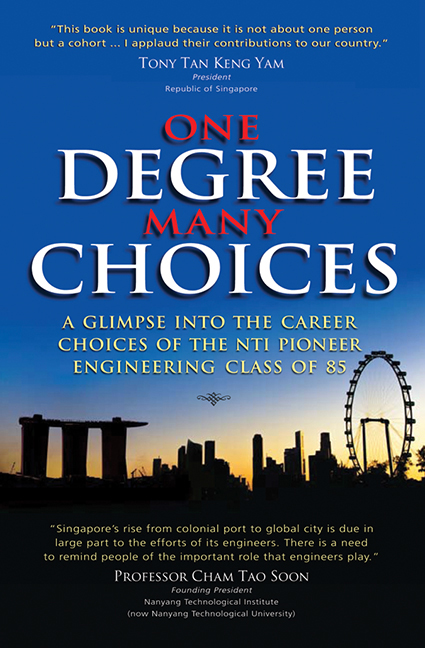 One Degree, Many Choices
One Degree, Many Choices from PART I - THE BEGINING
Published online by Cambridge University Press: 21 October 2015
“There is value in nation-building to retain the symbol of Nantah.”
— Lee Kuan Yew, Prime Minister of Singapore (1959 – 1990)NANYANG TECHNOLOGICALUNIVERSITY (NTU) might never have existed if not for the intervention of former Prime Minister Lee Kuan Yew. NTU's predecessor Nanyang Technological Institute (NTI) was supposed to have a different name and be built on a plot of land in the eastern part of the island. It was PM Lee who stepped in to enable the construction of NTI on the sprawling Jurong campus that Singaporeans know of today.
The story of NTI began with the former Nanyang University (NU) and its departure from the campus on which NTU now stands. In 1953, the Chinese Chamber of Commerce in Singapore proposed the setting up of a Chinese-language university that would attract students from the region. The project received support from a wide spectrum of the Chinese community, from wealthy merchants to trishaw riders and hawkers in Singapore, Malaya and the Borneo territories. NU, which opened to much fanfare in 1956, became the symbol of Chinese language, culture and education.
However, those who entered NU in the 1970s with high expectations found reality different upon graduation. Being educated in Chinese, they found it hard to get jobs in an economy where English is the working language. Prime Minister Lee Kuan Yew could not accept the prospect of several hundred students wasting their future each year. In 1975, he tasked Education Minister Dr Lee Chiaw Meng to convert NU into an English-language university. It was not successful. In 1978, PM Lee tried another method. He persuaded the NU Council and senate members to move the whole university into the campus of the University of Singapore at Bukit Timah. In 1980, the two universities merged to become the National University of Singapore (NUS).
At that time, there was a pressing need to increase the number of engineers to cope with the shift of Singapore's economy to one that focused more on high-technology, high value-add activities. In July 1980, the Council of Professional and Technical Education indicated that the number of engineering students should increase from 300 to 1,200 a year. There were three possibilities.
To save this book to your Kindle, first ensure [email protected] is added to your Approved Personal Document E-mail List under your Personal Document Settings on the Manage Your Content and Devices page of your Amazon account. Then enter the ‘name’ part of your Kindle email address below. Find out more about saving to your Kindle.
Note you can select to save to either the @free.kindle.com or @kindle.com variations. ‘@free.kindle.com’ emails are free but can only be saved to your device when it is connected to wi-fi. ‘@kindle.com’ emails can be delivered even when you are not connected to wi-fi, but note that service fees apply.
Find out more about the Kindle Personal Document Service.
To save content items to your account, please confirm that you agree to abide by our usage policies. If this is the first time you use this feature, you will be asked to authorise Cambridge Core to connect with your account. Find out more about saving content to Dropbox.
To save content items to your account, please confirm that you agree to abide by our usage policies. If this is the first time you use this feature, you will be asked to authorise Cambridge Core to connect with your account. Find out more about saving content to Google Drive.